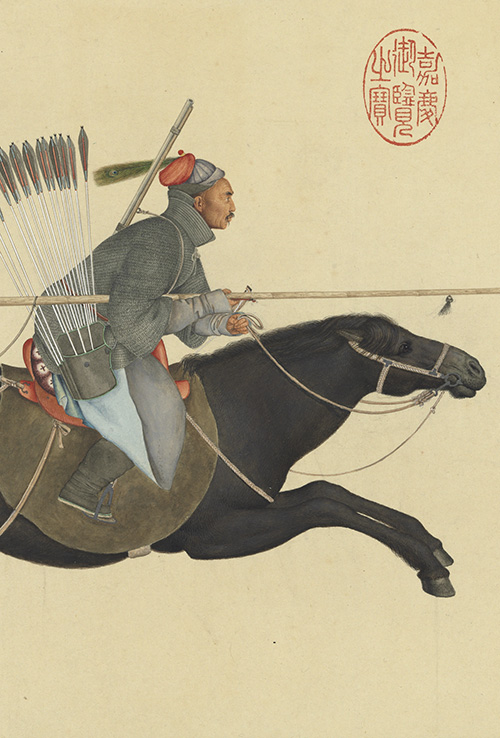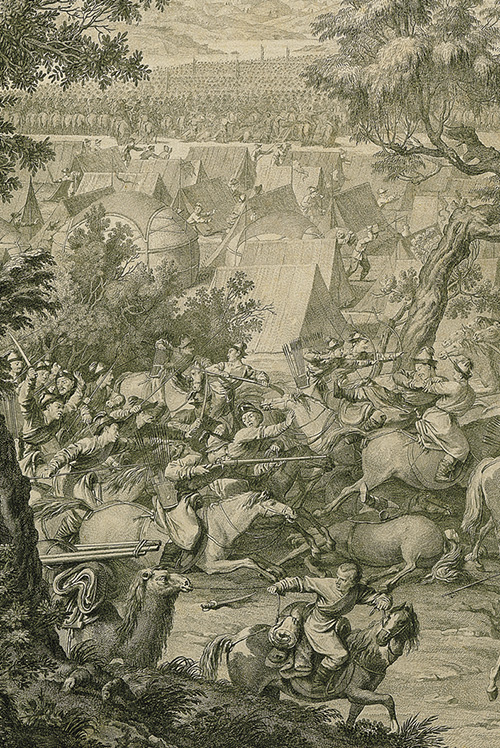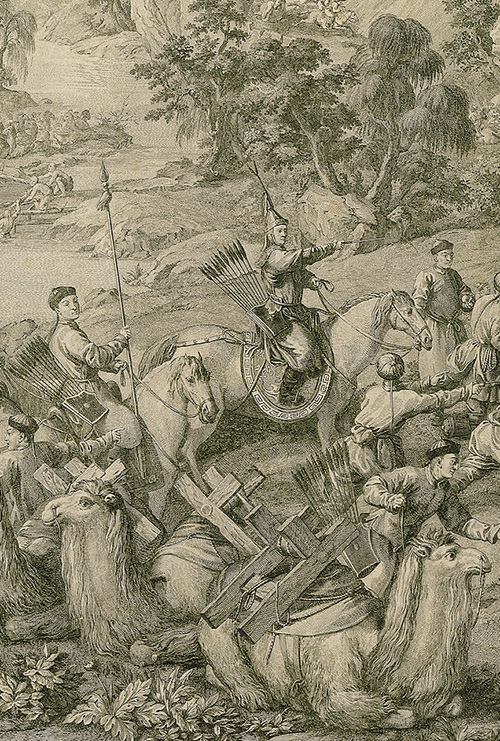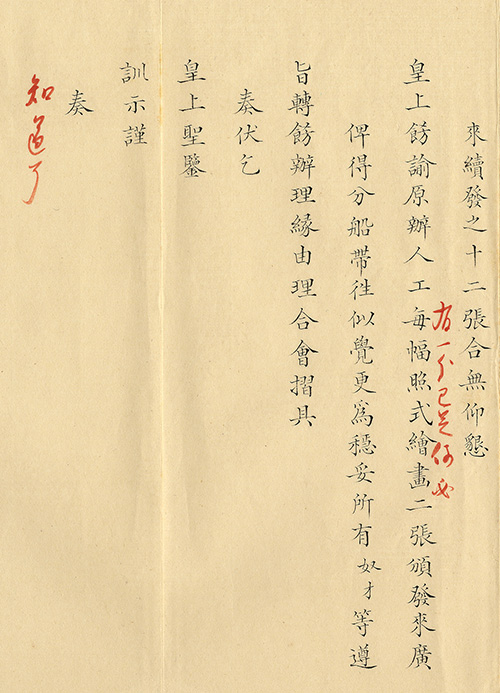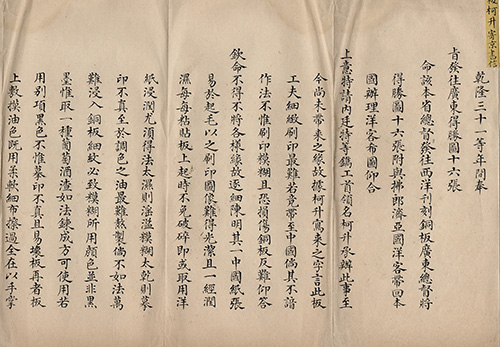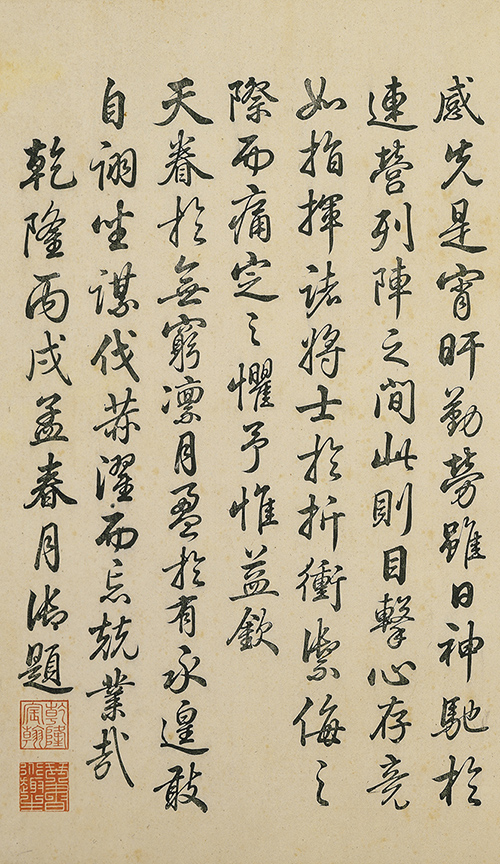In 1764, Giuseppe Castiglione at the advanced age of 76 received orders to prepare drawings for sixteen illustrations of Qing military conquests in quelling rebellions by Dzungar and Muslim tribes. The Qianlong emperor decreed that the illustrations be sent to Paris for etching on copper plates and printing. Castiglione was personally responsible for the drafts of the storming of the camp at Gädän-Ola and lifting the siege at Black Water River, representing the last major project he did for the Qing court.
The sets of copperplate prints for these military victories took twelve years to complete and involved ten trips to China. The Qianlong emperor then personally composed a preface and poetry for them. He also ordered officials to compose colophons, with the texts printed in eighteen leaves using traditional woodblock printing. Combined with the sixteen copperplate prints made in France, the entire album consisted of 34 leaves of texts and images. Employing realistic methods of rendering in perspective, they synthesize the arts of China and the West to manifest the illustrious achievements of the Qing court. After these illustrations were completed, the Qianlong emperor presented numerous copies to favored members in the imperial family and his courtiers, also having them sent not only to his temporary palaces but also government offices for display to spread the message of imperial power. Afterwards, when the Qing court engaged in other military campaigns, it continued to use copperplate printing as a way to commemorate its victories. Thus, the original set serves as a forerunner for the Great Qing Empire's adoption of Western copperplate engraving technology to commemorate and publicize its achievements.
The exhibit includes not only translations of letters and archived imperial decrees and documents on the copperplate prints related to this military conquest in what is now Xinjiang, but also official bi-ographical materials on Giuseppe Castiglione written by the Qing court along with two galley proofs of the drawings he did and the final prints. On one hand, they present the life and artistic ac-complishments of this Italian artist at the Qing court, and on the other reflect the emperor's ultimate achievement in art and war during the eighteenth century.
Lang Shining (Giuseppe Castiglione, 1688-1766), Qing dynasty
Ayusi Sweeping Bandits with a Lance
- Handscroll, ink and colors on paper
- frontispiece: 27.1 x 56.5 cm
- painting: 27.1 x 104.4 cm
Ayusi (birth and death dates unknown) was a Mongol Dzungar who submitted to and later fought for the Qing court. In the twentieth year of Qianlong's reign (1755), the Dzungar Khan Dawachi colluded with Tsarist Russia and in a pincher attack by Qing forces, he was forced to flee to Gädän-Ola, where he put up stubborn resistance. While there, Ayusi led a nighttime cavalry raid on the Dzungar rebel camp, scattering them. Though Dawachi managed to escape, he was captured later by Khojis. Ayusi was commended for his merits in battle and Giuseppe Castiglione ordered to do an oil portrait and a large painting of "Victory at the Military Camp." Ayusi's portrait was also transferred to this handscroll painting of him racing on horseback with a lance, arrows, and a rifle.
Here, Castiglione has completely done away with the background, realistically portraying Ayusi wearing a peacock-feather warming cap, an overcoat to protect against arrows, and a musket slung over his shoulder. With a bag of arrows at his waist, he holds onto reins with one hand and a lance with the other, leading his horse against the enemy.
Copperplate engraving of the "Storming of the Camp at Gädän-Ola" from the Victory in the Pacification of Dzungars and Muslims
- Drafted by Giuseppe Castiglione, 1688-1766
- Directed by Charles-Nicolas Cochin, 1715-1790
- Engraved by J. Ph. Le Bas, 1707-1783
- Finalized in 1769 at Paris
Copperplate engraving of the "Storming of the Camp at Gädän-Ola" from the Victory in the Pacification of Dzungars and Muslims
- Drafted by Giuseppe Castiglione, 1688-1766
- Directed by Charles-Nicolas Cochin, 1715-1790
- Engraved by J. Ph. Le Bas, 1707-1783
- Finalized in 1771 at Paris
Palace memorial on the delivery of four illustrations of the Victory in the Pacification of Dzungars and Muslims to France for copperplate production
- Submitted by YANG Tingzhang
- Governor-general of Guangdong and Guangxi
- FANG Tiyu, Superintendent of the Guangdong Customs
Grand Council copy of a palace memorial detailing of a letter brought by a foreign trader from the French master engraver Charles-Nicolas Cochin on the production of copperplates
- Translated by Michel Benoist(1715-1774) and Jean-Joseph Marie Amiot(1718-1793)
